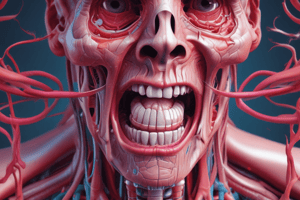Podcast
Questions and Answers
The stomodeum, which forms the primitive oral cavity, is primarily lined by which type of tissue?
The stomodeum, which forms the primitive oral cavity, is primarily lined by which type of tissue?
- Neural crest
- Endoderm
- Ectoderm (correct)
- Mesoderm
Which of the following processes primarily contributes to the formation of the stomodeum?
Which of the following processes primarily contributes to the formation of the stomodeum?
- Longitudinal folding of the early embryo. (correct)
- Cranial folding of the neural tube.
- Lateral migration of neural crest cells.
- Apical constriction of surface ectoderm.
From which of the following structures is the forehead primarily derived?
From which of the following structures is the forehead primarily derived?
- Frontonasal process (correct)
- Maxillary process
- Mandibular process
- Hyoid arch
Which facial component is formed by the fusion of mandibular prominences?
Which facial component is formed by the fusion of mandibular prominences?
What developmental issue arises if the medial nasal processes fail to fuse correctly?
What developmental issue arises if the medial nasal processes fail to fuse correctly?
Which structure carries the four incisor teeth?
Which structure carries the four incisor teeth?
What is the origin of the lateral parts of the upper lip?
What is the origin of the lateral parts of the upper lip?
With which structure does the primary palate fuse during palatogenesis?
With which structure does the primary palate fuse during palatogenesis?
The secondary palate originates from which of the following?
The secondary palate originates from which of the following?
What is the role of palatine shelves in the development of the secondary palate?
What is the role of palatine shelves in the development of the secondary palate?
Which of the following best describes the location of the palatine bone?
Which of the following best describes the location of the palatine bone?
What cavities does the palatine bone contribute to forming?
What cavities does the palatine bone contribute to forming?
Which suture marks the fusion point between the secondary and primary palates?
Which suture marks the fusion point between the secondary and primary palates?
In adults, what anatomical feature indicates the junction between the primary and secondary palates?
In adults, what anatomical feature indicates the junction between the primary and secondary palates?
Which of the following defines cleft palate?
Which of the following defines cleft palate?
Which of the following is a characteristic of the stomodeum?
Which of the following is a characteristic of the stomodeum?
What separates the primitive oral cavity from the pharynx?
What separates the primitive oral cavity from the pharynx?
Which of the following processes is NOT derived from the frontonasal process?
Which of the following processes is NOT derived from the frontonasal process?
What structures are formed from the mandibular process?
What structures are formed from the mandibular process?
What is the correct order of events regarding the development of the palate?
What is the correct order of events regarding the development of the palate?
Flashcards
What is the Stomodeum?
What is the Stomodeum?
A narrow, slit-like opening in the face during embryonic development, which forms primarily through longitudinal folding.
What is the Frontonasal Process?
What is the Frontonasal Process?
A single, ventral structure relative to the forebrain that contributes to the development of the face.
What is the Maxillary Process?
What is the Maxillary Process?
Paired structures developing from the cranial part of the first branchial arch that contribute to facial development.
What is the Mandibular Process?
What is the Mandibular Process?
Signup and view all the flashcards
What does the Frontonasal Process form?
What does the Frontonasal Process form?
Signup and view all the flashcards
What does the Maxillary Process form?
What does the Maxillary Process form?
Signup and view all the flashcards
What does the Mandibular Process form?
What does the Mandibular Process form?
Signup and view all the flashcards
What is the Intermaxillary Segment?
What is the Intermaxillary Segment?
Signup and view all the flashcards
What is the Labial component?
What is the Labial component?
Signup and view all the flashcards
What is the alveolar process?
What is the alveolar process?
Signup and view all the flashcards
What is the Palatal component?
What is the Palatal component?
Signup and view all the flashcards
What happens when Nasal Processes fuse?
What happens when Nasal Processes fuse?
Signup and view all the flashcards
What facial structure derived from the Frontonasal process?
What facial structure derived from the Frontonasal process?
Signup and view all the flashcards
When does Palatogenesis occur?
When does Palatogenesis occur?
Signup and view all the flashcards
When does the Primary Palate begin to develop?
When does the Primary Palate begin to develop?
Signup and view all the flashcards
How do Lateral Palatine Processes grow?
How do Lateral Palatine Processes grow?
Signup and view all the flashcards
What happens to bone during palate formation?
What happens to bone during palate formation?
Signup and view all the flashcards
What do palatine shelves do?
What do palatine shelves do?
Signup and view all the flashcards
What are key facts about the Palatine Bone?
What are key facts about the Palatine Bone?
Signup and view all the flashcards
What describes the Primary Palate?
What describes the Primary Palate?
Signup and view all the flashcards
Study Notes
- Development of the oral cavity with Dr. Buvana Balamugundan.
Primitive Oral Cavity (3-4 Weeks)
- The stomodeum is a narrow slit-like opening in the face.
- It forms primarily through the longitudinal folding of the early embryo.
- The stomodeum is lined by ectoderm.
- The stomodeum lies between the brain capsule (above) and the pericardial sac (below) during development.
- A thin oral membrane at the back of the cavity separates the primitive mouth from the pharynx, which disappears later.
Facial Structures Derived from Stomodeum
- Face derives from structures around the stomodeum.
- The frontonasal process is single and ventral to the forebrain.
- Maxillary processes are paired and develop from the cranial part of the first branchial arch.
- Mandibular processes are paired and develop from the caudal part of the first branchial arch.
Derivatives of Facial Components
- Frontonasal process forms the forehead, external nose, nasal cavity, and nasal septum.
- Maxillary process forms the lateral parts of the upper lip and upper parts of the cheek.
- Mandibular process forms the chin, lower lip, and lower part of the cheek.
Intermaxillary Segment
- Two medial nasal processes fuse to form the intermaxillary segment.
- If this fusion fails, an orofacial cleft may develop in newborns.
- The intermaxillary segment consists of 3 components: labial (philtrum of the upper lip), upper jaw (alveolar process carrying 4 incisor teeth), and palatal (triangular primary palate or premaxilla).
Nasal Processes
- Naso-medial processes grow quickly, pushing the frontal prominence.
- They fuse with the maxillary processes to complete the arch of the upper jaw.
- Maxillary processes grow medially, press medial nasal processes, and fuse with them.
- Maxillary processes also fuse with lateral nasal and mandibular processes.
- Mandibular prominences fuse and form the chin, lower lip, and lower cheek regions (mandible).
Palatogenesis
- Palatogenesis begins at the end of the 5th week and completes by the end of the 12th week.
- The palate develops from two primordia: the primary and secondary palates.
Primary Palate
- The primary palate begins to develop early in the 6th week.
- It originates from the deep part of the intermaxillary segment, as the median palatine process.
- It fuses with the developing secondary palate.
- The primary palate represents a small part anterior to the incisive fossa of the adult hard palate.
Secondary Palate
- The secondary palate develops from the internal aspect of the maxillary processes, as the lateral palatine process, beginning in the 6th week.
- Lateral palatine processes elongate and ascend to a horizontal position above the tongue.
- Bone develops in the anterior part, forming the hard palate.
- The posterior part develops as muscular soft palate.
- Lateral palatine processes grow medially and fuse in the median plane.
- It also fuses with the primary palate and the nasal septum.
Development of Secondary Palate
- The main palate is formed by palatine shelves growing inwards into the upper pharynx.
- Palatine shelves grow toward each other and above the tongue.
- The nasal septum grows downwards towards the palatine shelves.
Palatine Bone
- The palatine bone is a paired bone located between the maxilla and the pterygoid process of the sphenoid bone.
- It participates in building the oral and nasal cavities, and the orbits within the skull.
- The quadrilateral horizontal plate posterior to the maxilla has a nasal (superior) and a palatine (inferior/oral) surface.
- The anterior border is serrated and attaches to the palatine process of the maxilla at the palatomaxillary (transpalatine) suture.
Permanent Palate
- The primary palate results from the fusion of medial nasal processes.
- The secondary palate results from the fusion of shelf-like outgrowths, the palatine shelves from the inner aspect of maxillary processes.
- The secondary and primary palates fuse anteriorly in a 'Y' shape.
- Each limb passes between the lateral incisor and canine teeth.
- The junction between the primary and secondary palate is represented by the incisive fossa in adults.
Anomalies Related to Palate
- Cleft palate is a birth defect with an opening in the oral cavity due to a lack of tissue development.
- Cleft palate is associated with craniofacial and genetic sequences or syndromes.
- Examples of syndromes: Pierre Robin sequence, Treacher-Collins syndrome, and Craniofacial microsomia.
Studying That Suits You
Use AI to generate personalized quizzes and flashcards to suit your learning preferences.





